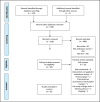A systematic review of ambulance service-based randomised controlled trials in stroke
- PMID: 37405524
- PMCID: PMC10641071
- DOI: 10.1007/s10072-023-06910-w
A systematic review of ambulance service-based randomised controlled trials in stroke
Abstract
Background: Treatment for stroke is time-dependent, and ambulance services play a vital role in the early recognition, assessment and transportation of stroke patients. Innovations which begin in ambulance services to expedite delivery of treatments for stroke are developing. However, research delivery in ambulance services is novel, developing and not fully understood.
Aims: To synthesise literature encompassing ambulance service-based randomised controlled interventions for acute stroke with consideration to the characteristics of the type of intervention, consent modality, time intervals and issues unique to research delivery in ambulance services. Online searches of MEDLINE, EMBASE, Web of Science, CENTRAL and WHO IRCTP databases and hand searches identified 15 eligible studies from 538. Articles were heterogeneous in nature and meta-analysis was partially available as 13 studies reported key time intervals, but terminology varied. Randomised interventions were evident across all points of contact with ambulance services: identification of stroke during the call for help, higher dispatch priority assigned to stroke, on-scene assessment and clinical interventions, direct referral to comprehensive stroke centres and definitive care delivery at scene. Consent methods ranged between informed patient, waiver and proxy modalities with country-specific variation. Challenges unique to the prehospital setting comprise the geographical distribution of ambulance resources, low recruitment rates, prolonged recruitment phases, management of investigational medicinal product and incomplete datasets.
Conclusion: Research opportunities exist across all points of contact between stroke patients and ambulance services, but randomisation and consent remain novel. Early collaboration and engagement between trialists and ambulance services will alleviate some of the complexities reported.
Registration number: PROSPERO 2018CRD42018075803.
Keywords: Ambulance; Emergency medical services; Paramedic; Stroke; Systematic review.
© 2023. The Author(s).
Conflict of interest statement
JPA was supported, in part, by a NIHR health and care research scholarship, and is supported, in part, by a Nottingham University Hospitals NHS Trust Research & Innovation Award.
Figures
Similar articles
-
Time intervals and distances travelled for prehospital ambulance stroke care: data from the randomised-controlled ambulance-based Rapid Intervention with Glyceryl trinitrate in Hypertensive stroke Trial-2 (RIGHT-2).BMJ Open. 2022 Nov 21;12(11):e060211. doi: 10.1136/bmjopen-2021-060211. BMJ Open. 2022. PMID: 36410799 Free PMC article. Clinical Trial.
-
Challenges and Experiences in Multicenter Prehospital Stroke Research: Narrative Data from the Rapid Intervention with Glyceryl Trinitrate in Hypertensive Stroke Trial-2 (RIGHT-2).Prehosp Emerg Care. 2024;28(6):832-840. doi: 10.1080/10903127.2023.2287171. Epub 2023 Dec 19. Prehosp Emerg Care. 2024. PMID: 38019218 Free PMC article. Clinical Trial.
-
Why are people without medical needs transported by ambulance? A study of indications for pre-hospital care.Eur J Emerg Med. 2007 Jun;14(3):151-6. doi: 10.1097/MEJ.0b013e3280146508. Eur J Emerg Med. 2007. PMID: 17473609
-
Paramedic management of back pain: a scoping review.BMC Emerg Med. 2022 Aug 9;22(1):144. doi: 10.1186/s12873-022-00699-1. BMC Emerg Med. 2022. PMID: 35945506 Free PMC article.
-
Community first responders for out-of-hospital cardiac arrest in adults and children.Cochrane Database Syst Rev. 2019 Jul 19;7(7):CD012764. doi: 10.1002/14651858.CD012764.pub2. Cochrane Database Syst Rev. 2019. PMID: 31323120 Free PMC article.
Cited by
-
Pre-hospital transdermal glyceryl trinitrate for transient ischaemic attack: Data from the RIGHT-2 trial.Eur J Neurol. 2024 Dec;31(12):e16502. doi: 10.1111/ene.16502. Epub 2024 Oct 11. Eur J Neurol. 2024. PMID: 39392040 Free PMC article. Clinical Trial.
References
-
- Powers WJ, et al. 2018 Guidelines for the early management of patients with acute ischemic stroke: a guideline for healthcare professionals from the American Heart Association/American Stroke Association. Stroke. 2018;49(3):e46–e110. - PubMed
-
- The Stroke Association (2017) State of the nation: stroke statistics 2017. Stroke Association, pp 1–38. Available from www.stroke.org.uk/sites/default/files/state_of_the_nation_2017_final_1.pdf. Accessed 25 Nov 2018
Publication types
MeSH terms
LinkOut - more resources
Full Text Sources
Medical
Miscellaneous




